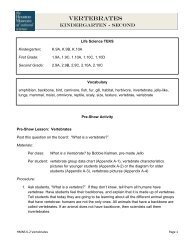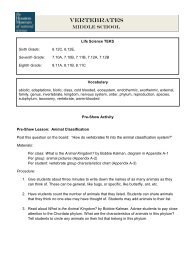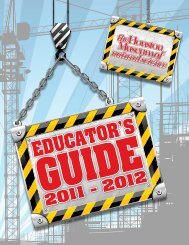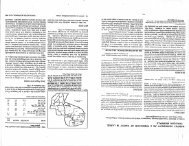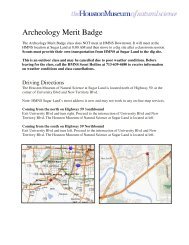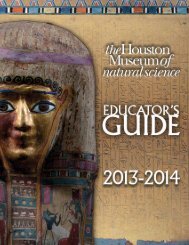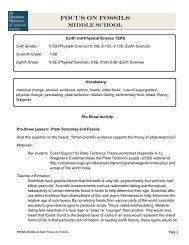HMNS Scout Program Environmental Science Merit Badge ...
HMNS Scout Program Environmental Science Merit Badge ...
HMNS Scout Program Environmental Science Merit Badge ...
Create successful ePaper yourself
Turn your PDF publications into a flip-book with our unique Google optimized e-Paper software.
<strong>HMNS</strong> <strong>Scout</strong> <strong>Program</strong><br />
<strong>Environmental</strong> <strong>Science</strong> <strong>Merit</strong> <strong>Badge</strong><br />
Information for Troop Leaders and Advancement Chairs<br />
<strong>HMNS</strong> <strong>Scout</strong> <strong>Program</strong> has an open door policy. Parents are welcomed and encouraged to sit in on<br />
classes with their child, and Troop leaders may observe any class. Parents and leaders may come and<br />
go as they please in any scout class. If you do not have a scout registered for a class you wish to<br />
observe, please let us know by sending an email to scouts@hmns.org. You WILL learn something!<br />
For all <strong>HMNS</strong> <strong>Scout</strong> <strong>Program</strong> classes, each requirement is signed off individually; if a requirement has not<br />
been completed to the satisfaction of the instructor, credit will not be given for that requirement.<br />
Individual attention will be given to any scout in need, so that each scout has every opportunity to the<br />
complete badge.<br />
The <strong>Environmental</strong> <strong>Science</strong> <strong>Merit</strong> badge is required for the rank of Eagle and is one of the harder badges<br />
to earn with more advanced concepts. We will follow the requirements as precisely as possible and use<br />
the scientific method format for all experiments (hypothesis, experiment, data collecting, conclusion).<br />
The <strong>Environmental</strong> <strong>Science</strong> badge takes three days to complete. We complete all requirements in class<br />
with no outside work.<br />
Method of Fulfilling Requirements:<br />
Requirement 1<br />
Make a timeline of the history of environmental science in America. Identify the contribution made by the Boy<br />
<strong>Scout</strong>s of America to environmental science. Include dates, names of people or organizations, and important events.<br />
<strong>Scout</strong>s will use a web site that describes the eras of <strong>Environmental</strong>ism: Ancient Civilizations, Middle Ages<br />
& Renaissance, Enlightenment, Industrial Revolution, Progressive, and the decades of the 20 th century, to<br />
complete a fill-in-the-blank timeline. <strong>Scout</strong>s will discuss how BSA has contributed to the study and health<br />
of the environmental.<br />
Requirement 2<br />
Define the following terms: population, community, ecosystem, biosphere, symbiosis, niche, habitat, conservation,<br />
threatened species, endangered species, extinction, pollution prevention, brownfield, ozone, watershed, airshed,<br />
nonpoint source, hybrid vehicle, fuel cell.<br />
<strong>Scout</strong>s will define terms, then complete a scavenger hunt in the Hall of Texas Wildlife to gain a better<br />
understanding.<br />
Requirement 3A, Option 1<br />
Conduct an experiment to find out how living things respond to changes in their environments. Discuss your<br />
observations with your counselor.<br />
<strong>Scout</strong>s will conduct experiments by changing the environmental conditions (light, temperature, and<br />
moisture) of mealworms. Experiment conclusions will be compared to real world conditions and how<br />
mealworms would react to changes in their habitat.
Requirement 3B, Option 1<br />
Perform an experiment to test for particulates that contribute to air pollution. Discuss your findings with your<br />
counselor.<br />
<strong>Scout</strong>s will build air pollution collectors to be set outside for several days at home and then brought back<br />
to the class. Particles collected will be described and counted, and samples from different locations will<br />
be compared. Using the internet, scouts will investigate the current pollution and pollen count.<br />
Requirement 3C, Option 1<br />
Conduct an experiment to identify the methods that could be used to mediate (reduce) the effects of an oil spill on<br />
waterfowl.<br />
<strong>Scout</strong>s will experiment with different methods of cleanup on a model oil spill including water, animal and<br />
bird cleanup. After recording which methods worked best, they will describe how the model cleanup<br />
compares to methods used in real-world situations.<br />
Requirement 3D, Option 1<br />
Conduct an experiment to illustrate soil erosion by water. Take photographs or make a drawing of the soil before<br />
and after your experiment, and make a poster showing your results. Present your poster to your patrol or troop.<br />
Using prepared trays of bare soil, a paper slurry coating soil, and grass growing in soil, scouts will<br />
observe and diagram the amount of erosion from water flowing down the tray. Conclusions will be drawn<br />
about what causes erosion and what can be done to control erosion. Also, conclusions will be made<br />
about flood control, as this is a more common problem in the Houston area.<br />
Requirement 3E, Option 1<br />
Do research on one endangered species found in your state. Find out what its natural habitat is, why it is<br />
endangered, what is being done to preserve it, and how many individual organisms are left in the wild. Prepare a<br />
100-word report about the organism, including a drawing. Present your report to your patrol or troop.<br />
Using the Texas Parks and Wildlife website, scouts will research an endangered species of their choice in<br />
Texas and write a report including the required information.<br />
Requirement 3F, Option 3<br />
Perform an experiment on packaging materials to find out which ones are biodegradable. Discuss your conclusions<br />
with your counselor.<br />
<strong>Scout</strong>s will compare different samples of packing material and evaluate the biodegradability and<br />
“environmental friendliness” of each. Different methods of degradation and the claims of store purchased<br />
packing material will be discussed.<br />
Requirement 4<br />
Choose two outdoor study areas that are very different from one. Mark off a plot of 4 square yards in each study<br />
area, and count the number of species found there. Estimate how much space is occupied by each plant species and<br />
the type and number of nonplant species you find. Write a report that adequately discusses the biodiversity and<br />
population density of these study areas. Discuss your report with your counselor.<br />
The first study plot will be in a weedy lawn area. <strong>Scout</strong>s will catalog and describe each plant type in the<br />
plot. Using three random transect lines, plants and non-plant material will be sampled to give an estimate<br />
of the diversity and percentage ground cover of the area. This sampling will be compared to the transect<br />
method used to estimate the lumber type wood in a large timber stand. A second plot in an area with<br />
native plants growing will be sampled for diversity. This plot will show the natural progression of a plant
community from bare soil to forest. <strong>Scout</strong>s will compare the diversity of the controlled lawn area to the<br />
wild native habitat.<br />
Requirement 5<br />
Using the construction project provided or a plan you create on your own, identify the items that would need to be<br />
included in an environmental impact statement for the project planned.<br />
<strong>Scout</strong>s will decide on an example construction project close to the museum. Benefits and problems of<br />
the construction problem will be listed, and then the value of the project will be debated. Effects on<br />
erosion, run-off, pollution, wildlife and plants, and social community will be determined, and a final<br />
evaluation of the environmental impact will be made.<br />
Requirement 6<br />
Find out about three career opportunities in environmental science. Pick one and find out the education, training,<br />
and experience required for this profession. Discuss this with your counselor, and explain why this profession might<br />
interest you.<br />
By reviewing the experiments completed, scouts will name and discuss careers available. These may<br />
include timber stand manager, pollution control, environmental engineer, environmental law, ecologist,<br />
and wildlife, rangeland, and natural resources management.




